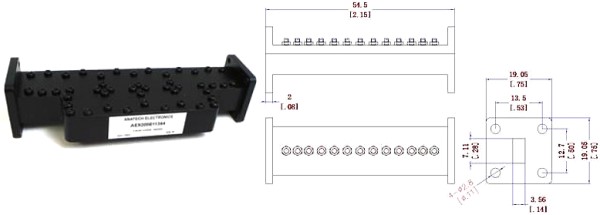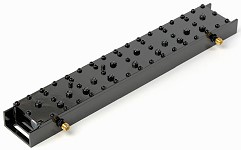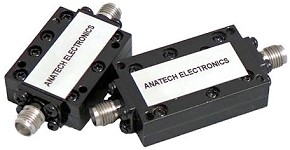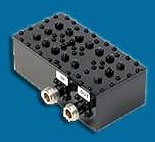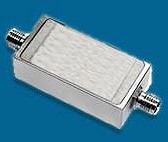Anatech Electronics October 2021 Newsletter |
||

Press Release Archives: 2024 | 2023 | 2022 | 2021 |2020 2019 | 2018 | 2017 | 2016 | 2015 2014 | 2013 | 2012 | 2011 | 2010 2009 | 2008 | 2007 | 2006 | 2005 Content is copyright of company represented. Page format, custom text and images are RF Cafe copyright - do not distribute.
Sam Benzacar of Anatech Electronics, an RF and microwave filter company, has published his October 2021 newsletter that features his short op−ed entitled "A Solution Has Arrived for Deploying Millimeter-Wave 5G," where he notes that early driving trials conducted by equipment supplier Movandi demonstrate consistent minimum data rates of 1 Gbps are achievable even in urban areas. The scheme involves massive deployment of mm-wave repeaters (effectively small cells), which network planners now believe will be a more reliable and affordable solution to towers due to the extreme signal attenuation (line-of-sight and within obstacles) in the tens of GHz realm. Sam also presents some relevant industry news items as well. A Word from Sam Benzacar A Solution Has Arrived for Deploying Millimeter-Wave 5G
Last month in this column, I suggested that since deploying 5G infrastructure at millimeter wavelengths is already difficult, doing the same at even higher frequencies would be problematic. I stand by that suggestion, but one thing has changed: It appears there's now a viable solution for "cost-effectively" deploying millimeter-wave infrastructure by using repeaters. Before this, most analysts pegged a figure of nationwide millimeter-wave 5G deployment at about $65 billion. While the repeater concept is not new, its deployment is just beginning for 5G, and at the moment there are only two companies making the collection of components required to implement it -- Movandi and Pivotal Commware. But don't be surprised if others enter this market because it seems to solve the biggest problem posed by millimeter wavelengths -- the need for vast numbers of small cells almost everywhere to deliver the gigabit-level data rates envision for 5G. Like everything associated with 5G, the solution is complex, as it requires a combination of active phased-array antennas, AI, and communication to and from cloud-based data centers. That said, the benefit is that it can potentially reduce the amount of infrastructure and thus cost by about 50% because fewer small-cell base stations are required. So not surprisingly, Verizon has adopted this approach in its Ultra Wideband 28 GHz network and others seem to be following their lead. The concept can be used indoors as well as outdoors because the repeaters and their associated high-gain antennas increase EIRP and can steer the beam in real-time based on traffic patterns and other data. Beam steering and higher output power should also help reduce the cost of fixed wireless access deployments.
So, while operating it 200 GHz still seems like a fantasy to me, it appears that making millimeter-waves "work" for 5G has now become economically feasible. Anatech Electronics has been providing standard and custom RF and microwave filters and other filter-based components to solve interference problems for utilities, oil and gas companies, and organization with similar requirements for more than 30 years, and we can solve yours as well. So, reach out to us with your most challenging problems at (973) 442-7272 or visit our website at anatechelectronics.com. DARPA Wants to Beam Electricity in Space with Lasers
Tracking Guns with RFID Tags Backfires
ITU Creates First 5G "Non-Cellular" Standard
The standard supports the use of shared spectrum over internationally recognized frequencies including 1.9 GHz. Non-cellular 5G is different than cellular 5G as it has a decentralized network, so every device becomes a node and a route, which essentially makes each one a base station that can determine the best propagation path. The standard claims to be the first 5G technology that supports shared spectrum and multiple networks within frequencies used for mobile communications. New Compass Call Takes to the Air
A
Getting Ready for 5G: Anatech Electronics introduce New Ka band 30.5 GHz Waveguide Band Pass Filter. Featuring a center frequency of 30.5 GHz, a bandwidth of 1000 MHz, an Insertion Loss 1 dB Max, and a Power Handling is 20 watts.
Anatech Electronics Introduces a New Line of Suspended Stripline and Waveguide Type RF Filters
Check out Our Filter Products
Cavity Band Pass Filters LC Band Pass Filters Cavity Bandstop/Notch Filter About Anatech Electronics Anatech Electronics, Inc. (AEI) specializes in the design and manufacture of standard and custom RF and microwave filters and other passive components and subsystems employed in commercial, industrial, and aerospace and applications. Products are available from an operating frequency range of 10 kHz to 30 GHz and include cavity, ceramic, crystal, LC, and surface acoustic wave (SAW), as well as power combiners/dividers, duplexers and diplexers, directional couplers, terminations, attenuators, circulators, EMI filters, and lightning arrestors. The company's custom products and capabilities are available at www.anatechelectronics.com. Contact: Anatech Electronics, Inc. 70 Outwater Lane Garfield, NJ 07026 (973) 772-4242
Posted September 29, 2021 |
||

 By Sam Benzacar
By Sam Benzacar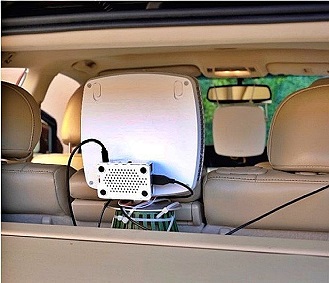 What I found most interesting is that one of
these companies, Movandi, has demonstrated that it is possible to achieve continuous
millimeter-wave coverage in a moving vehicle using Verizon's network, even when
conducting a Zoom call. They mounted two of their repeaters inside the car, one
behind the front window and another at the rear window (see figure) and connected
to the network with a Samsung 5G-enabled smartphone. The test managed to achieve
data rates up to 3 Gb/s in the downlink path while traveling around De Anza Boulevard
in Cupertino, Calif., at 30 mph, never falling below 1 Gb/s. According to the company,
it didn't seem to matter much how the phone was held or where. It's the first time
I've ever seen this demonstrated but it shows that millimeter-wave mobility is achievable,
and the technology can be scaled downward to allow the entire radio and antenna
to integrated within the vehicle.
What I found most interesting is that one of
these companies, Movandi, has demonstrated that it is possible to achieve continuous
millimeter-wave coverage in a moving vehicle using Verizon's network, even when
conducting a Zoom call. They mounted two of their repeaters inside the car, one
behind the front window and another at the rear window (see figure) and connected
to the network with a Samsung 5G-enabled smartphone. The test managed to achieve
data rates up to 3 Gb/s in the downlink path while traveling around De Anza Boulevard
in Cupertino, Calif., at 30 mph, never falling below 1 Gb/s. According to the company,
it didn't seem to matter much how the phone was held or where. It's the first time
I've ever seen this demonstrated but it shows that millimeter-wave mobility is achievable,
and the technology can be scaled downward to allow the entire radio and antenna
to integrated within the vehicle.  DARPA has issued an SBIR
for the Breakthrough Technologies for Energy Web Dominance project with the goal
of developing safe optical power-beaming web networks of free-space lasers to transmit
electrical power using aircraft as receivers and relays of optical energy. The network
would consist of ground -based lasers sending power to airborne nodes that would
use the power for themselves after conversion and then relay the rest to other nodes.
DARPA program wants private industry participants to optimize efficiency for systems
with an energy flux of 1 kW per square meter and scalable to 100 kW per square meter.
The optical waveguides could be as simple as a mirror but will probably consist
of several components to redirect power to their intended recipients.
DARPA has issued an SBIR
for the Breakthrough Technologies for Energy Web Dominance project with the goal
of developing safe optical power-beaming web networks of free-space lasers to transmit
electrical power using aircraft as receivers and relays of optical energy. The network
would consist of ground -based lasers sending power to airborne nodes that would
use the power for themselves after conversion and then relay the rest to other nodes.
DARPA program wants private industry participants to optimize efficiency for systems
with an energy flux of 1 kW per square meter and scalable to 100 kW per square meter.
The optical waveguides could be as simple as a mirror but will probably consist
of several components to redirect power to their intended recipients.  The ITU just announced
the world's first non-cellular 5G technology standard designed to allow enterprises
to autonomously manage networks without operators. It's called ETSI DECT-2020 NR
and it will be included as part of the 5G standards in IMT-2020. The standard eliminates
some network infrastructure and a single point of failure. It would allow companies
to operate without intermediaries or subscription fees and store and consume data
as they see fit, which could be on the premises or in a cloud data center, or almost
anything in between.
The ITU just announced
the world's first non-cellular 5G technology standard designed to allow enterprises
to autonomously manage networks without operators. It's called ETSI DECT-2020 NR
and it will be included as part of the 5G standards in IMT-2020. The standard eliminates
some network infrastructure and a single point of failure. It would allow companies
to operate without intermediaries or subscription fees and store and consume data
as they see fit, which could be on the premises or in a cloud data center, or almost
anything in between.  The new Air Force EC-37B
Compass Call EW aircraft has completed its inaugural flight. The aircraft will update
the existing fleet of 10 EC-130H Compass Call aircraft and requires transferring
Lockheed Martin's Lockheed Martin-built mission systems to the new airframe. The
developer, L3Harris Technologies, chose the Gulfstream G550 Conformal Airborne Early
Warning Aircraft airframe for the new aircraft. It will have a variety of new sensors
as well as communication capability to provide enhanced stand-off jamming. Compass
Call has been a key EW platform for many years with the mission of massively disrupting
enemy command and control communications, radar, and navigation systems. The aircraft
will have a modular design to enable rapid new technology insertion and is considerably
faster than the EC-130H, weighs less, is smaller, and should cost less to operate.
The new Air Force EC-37B
Compass Call EW aircraft has completed its inaugural flight. The aircraft will update
the existing fleet of 10 EC-130H Compass Call aircraft and requires transferring
Lockheed Martin's Lockheed Martin-built mission systems to the new airframe. The
developer, L3Harris Technologies, chose the Gulfstream G550 Conformal Airborne Early
Warning Aircraft airframe for the new aircraft. It will have a variety of new sensors
as well as communication capability to provide enhanced stand-off jamming. Compass
Call has been a key EW platform for many years with the mission of massively disrupting
enemy command and control communications, radar, and navigation systems. The aircraft
will have a modular design to enable rapid new technology insertion and is considerably
faster than the EC-130H, weighs less, is smaller, and should cost less to operate.
